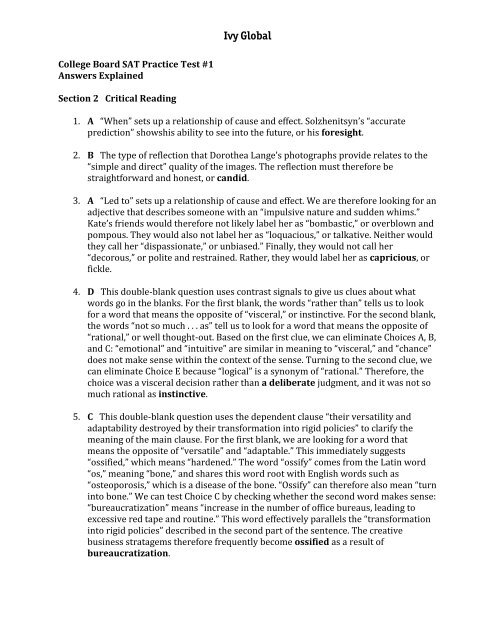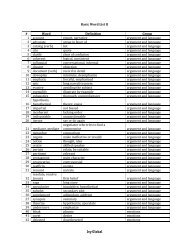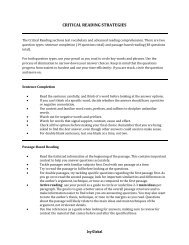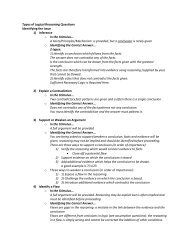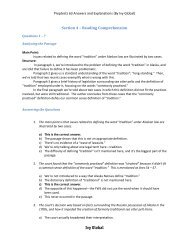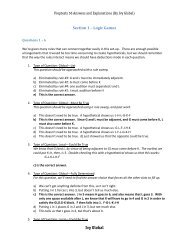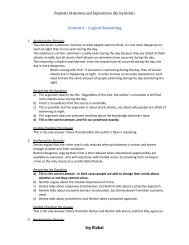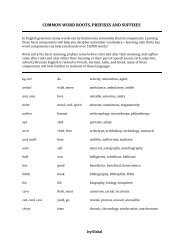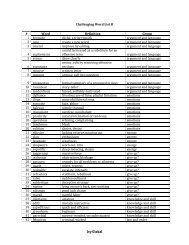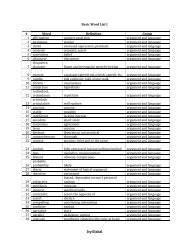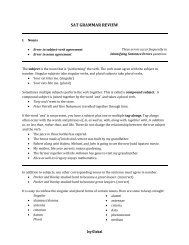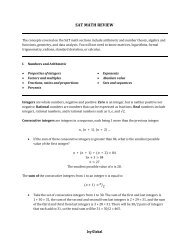College Board SAT Practice Test #1 Answers and - Ivy Global
College Board SAT Practice Test #1 Answers and - Ivy Global
College Board SAT Practice Test #1 Answers and - Ivy Global
Create successful ePaper yourself
Turn your PDF publications into a flip-book with our unique Google optimized e-Paper software.
<strong>Ivy</strong> <strong>Global</strong><strong>College</strong> <strong>Board</strong> <strong>SAT</strong> <strong>Practice</strong> <strong>Test</strong> <strong>#1</strong><strong>Answers</strong> ExplainedSection 2 Critical Reading1. A “When” sets up a relationship of cause <strong>and</strong> effect. Solzhenitsyn’s “accurateprediction” showshis ability to see into the future, or his foresight.2. B The type of reflection that Dorothea Lange’s photographs provide relates to the“simple <strong>and</strong> direct” quality of the images. The reflection must therefore bestraightforward <strong>and</strong> honest, or c<strong>and</strong>id.3. A “Led to” sets up a relationship of cause <strong>and</strong> effect. We are therefore looking for anadjective that describes someone with an “impulsive nature <strong>and</strong> sudden whims.”Kate’s friends would therefore not likely label her as “bombastic,” or overblown <strong>and</strong>pompous. They would also not label her as “loquacious,” or talkative. Neither wouldthey call her “dispassionate,” or unbiased.” Finally, they would not call her“decorous,” or polite <strong>and</strong> restrained. Rather, they would label her as capricious, orfickle.4. D This double-blank question uses contrast signals to give us clues about whatwords go in the blanks. For the first blank, the words “rather than” tells us to lookfor a word that means the opposite of “visceral,” or instinctive. For the second blank,the words “not so much . . . as” tell us to look for a word that means the opposite of“rational,” or well thought-out. Based on the first clue, we can eliminate Choices A, B,<strong>and</strong> C: “emotional” <strong>and</strong> “intuitive” are similar in meaning to “visceral,” <strong>and</strong> “chance”does not make sense within the context of the sense. Turning to the second clue, wecan eliminate Choice E because “logical” is a synonym of “rational.” Therefore, thechoice was a visceral decision rather than a deliberate judgment, <strong>and</strong> it was not somuch rational as instinctive.5. C This double-blank question uses the dependent clause “their versatility <strong>and</strong>adaptability destroyed by their transformation into rigid policies” to clarify themeaning of the main clause. For the first blank, we are looking for a word thatmeans the opposite of “versatile” <strong>and</strong> “adaptable.” This immediately suggests“ossified,” which means “hardened.” The word “ossify” comes from the Latin word“os,” meaning “bone,” <strong>and</strong> shares this word root with English words such as“osteoporosis,” which is a disease of the bone. “Ossify” can therefore also mean “turninto bone.” We can test Choice C by checking whether the second word makes sense:“bureaucratization” means “increase in the number of office bureaus, leading toexcessive red tape <strong>and</strong> routine.” This word effectively parallels the “transformationinto rigid policies” described in the second part of the sentence. The creativebusiness stratagems therefore frequently become ossified as a result ofbureaucratization.
<strong>Ivy</strong> <strong>Global</strong>6. D The author implies that being “human” includes the ability to enjoy thewondrous spectacles of the night sky, or to appreciate nature’s beauty.7. B A metaphor is a figure of speech in which a description of a person, place, orthing is enhanced by reference to something else. The author of this passage usesmetaphor in describing the “river of clouds”: although the clouds do not literallyflow in a river, this use of metaphorical language helps the reader to visualize thescene through comparison to a more tangible scene. Therefore, the rhetorical deviceprimarily featured in this passage is metaphorical language.8. C The passage outlines Augusta Ada King’s contributions to computer science <strong>and</strong>tells us how her life, lineage, <strong>and</strong> role as a female pioneer in her field “have turnedher into an icon.” The passage is therefore primarily concerned with summarizinghow <strong>and</strong> why Augusta Ada King is celebrated.9. A Note that the question asks not which statement the author would most likelyagree with but which statement the author would most likely disagree with. Be sureto read the question carefully so that you underst<strong>and</strong> what it is asking. The authormentions that Augusta Ada King was the daughter of the flamboyant poet LordByron <strong>and</strong> that “her fascinating life <strong>and</strong> lineage” have helped turn her into an icon.The author would therefore most likely disagree that her family history plays nopart in the fascination she arouses.10. D The author states that “Black Americans have managed to sustain links with thecontinent of their origin, against tremendous odds” <strong>and</strong> that “for over 300 yearsBlack Americans have kept various ties to Africa intact.” This relationship isreciprocal: “for as long as Black people in America have reached back to Africa tooffer <strong>and</strong> receive reassurance, reaffirmation, fraternity, <strong>and</strong> strength, Africans havereached to Black people in the Americas.” The primary purpose of this passage istherefore to emphasize the significance of an ongoing relationship.11. B The ancestors’ “message” to their descendants stresses the importance of kinshipcultural ties, <strong>and</strong> suggests that these foundations are essential to a people’s survival.These words are best characterized as cautionary advice.12. C As the author tells us, people feel an instinctive pull to their heritage <strong>and</strong> have aninborn curiosity about their origins. The proverb therefore shows people’sinherent interest in their history.13. E The author contrasts “shadowy” imaginings with “real” experience. Whereasexperience is known <strong>and</strong> verifiable, these imaginings are indistinct <strong>and</strong> unverifiable,or unsubstantiated.14. E The author’s description of the wondering suggests an initial sense ofuncertainty. However, there is a shift in tone in line 46 marked by the author’s use of“but.” The author then goes on to describe the significance of Black Americans’
<strong>Ivy</strong> <strong>Global</strong>contributions to literature, politics, music, <strong>and</strong> religion. Lines 42-50 therefore showa shift in feeling from doubt to pride.15. B The author relies primarily on broad generalizations that could apply to a widerange of people <strong>and</strong> situations. The author does not include many specific detailssuch as names, dates, or places.Choice A is incorrect. The author does not invent any hypothetical scenarios, whichwould be suggested by use of the words “if” or “imagine.”Choice C is incorrect. The author makes broad statements that may be based onhistorical facts but does not include specific details such as names, dates, or places.Choice D is incorrect. The author does not include any personal anecdotes <strong>and</strong> reliesmore on broad generalizations, as evidenced by his use of the pronoun “we,” ratherthan “I.”Choice E is incorrect. The author does not cite the work of any scholars in hisargument.This question asks about the author’s technique. Familiarize yourself with thekeywords associated with different types of evidence as outlined above.16. C Both passages call attention to the popular appeal of the Mona Lisa in the firstparagraph. The key words in this question are “call attention to.” We are looking foran aspect of the Mona Lisa that both passages not only address but also emphasizethe importance of.Choice A is incorrect. Passage 1 makes only passing reference to the smile (line 29),<strong>and</strong> Passage 2 does not address the smile at all.Choice B is incorrect. Passage 1 briefly postulates ponders the subject’s identity(lines 7-8), <strong>and</strong> Passage 2 does not discuss the subject’s identity.Choice D Is incorrect. Both passages discuss the artistic significance of the Mona Lisabut not its influence on artists, or how it changed the art world after it.Choice E is incorrect. Neither passage says the Mona Lisa is in deterioratingcondition. This answer is obviously wrong.When dealing with double passages, if a question asks about both passages, the bestapproach is usually to eliminate answers to do not apply to one of the passages.17. A The author of Passage 2 argues that “the renown of a masterpiece rests on asequence of events <strong>and</strong> historical agencies” (lines 67-68). The author wouldtherefore believe that the phenomena of popular attention given to the Mona Lisaare circumstances that may themselves have contributed to its fame.18. E Although the subject is “nobody special,” the painting itself is important becauseit set the st<strong>and</strong>ard for High Renaissance paintings. These two points show thecontrast between a woman’s ordinary status <strong>and</strong> her portrait’s aestheticsignificance.19. B The quotation serves to describe the impact of a technique on the painting, orcharacterize an effect.
<strong>Ivy</strong> <strong>Global</strong>20. A Passage 2, line 32 enumerates some of the subject’s features that bring instantrecognition. The author of Passage 1 concludes with a mention of the subject’s“famous smile” (line 29) <strong>and</strong> would therefore add her mouth to this list.21. D The “position” of many art critics refers to the idea that “there is something . . .inside the painting that speaks to us all” (lines 37-38). In this context, “position”most nearly means view.22. E This question is best approached by starting with the comments made by PaulBarolsky. He explains that Leonardo’s technique “creates a sense of texture <strong>and</strong>depth” (line 56), or three-dimensionality. The author of Passage 1 tells us thatLeonardo “built the illusion of three-dimensional features through layers <strong>and</strong> layersof thin, transparent glazes” (lines 21-23). Both authors would therefore agree thatthe painting gives the appearance of having three dimensions.23. E The author of Passage 2 uses the word “innate” in quotation marks to describe “amysterious yet almost palpable contact” between ourselves <strong>and</strong> the artists of greatpaintings (65-66). However, earlier he argues that we “should avoid succumbing . . .to the idea that inside every masterpiece that has remained alive for centuriessomething imponderable speaks to us” (59-62). The author’s use of quotation markstherefore serves to imply skepticism about a theory.24. C Passage 1 discusses the painting’s use of perspective, triangular composition, <strong>and</strong>use of light <strong>and</strong> shadow. Passage 2 examines the social <strong>and</strong> historical forces thathave turned the Mona Lisa into the best-known painting in the world. Therefore,Passage 1 focuses on the painting’s stylistic innovations, <strong>and</strong> Passage 2 seeksto account for its cultural preeminence.Choice A is incorrect. Passage 1 mentions the smile only in the last sentence, <strong>and</strong>Passage 2 does not discuss the mysterious qualities of the painting’s subject. It doesrefer to the mysterious qualities of the painting itself but displays skepticism aboutthe characterization.Choice B is incorrect. Passage 1 demonstrates how the painting diverged in style <strong>and</strong>appearance from prevailing norms, but Passage 2 does not discuss the backgroundof its creator.Choice D is incorrect. The author of Passage 1 does not know the identity of thesubject <strong>and</strong> therefore cannot speculate about the life of the subject. The author ofPassage 2 makes “the assumption that the renown of a masterpiece rests on asequence of events <strong>and</strong> historical agencies” (lines 67-68), suggesting that historicalinterpretations are indeed relevant.Choice E is incorrect. Passage 1 alludes to the artistic, but not the societal,importance of the painting; <strong>and</strong> Passage 2 does not debate its artistic merits.The best approach to this question is to treat it as two separate questions, oneasking about the author’s approach in Passage 1 <strong>and</strong> the other asking about theauthor’s approach in Passage 2. If the answer for either passage does not makesense, then that option can be eliminated entirely.
<strong>Ivy</strong> <strong>Global</strong>Section 3 Mathematics1. A Substitute x = 4 into each choice <strong>and</strong> multiply through to find the one that isgreatest in value.2. E Train B’s speed was 7mph. Train A’s speed was 3 times Train B’s speed, or 21mph. Train C’s speed was twice Train A’s, or 42 mph.3. B If the average (arithmetic mean) of x, 5x, <strong>and</strong> 6x is 8, then (x + 5x + 6x)/3 = 8.Simplify to solve: 12x/3 = 8 4x = 8 x = 2.4. D If no two points on the graph have the same x-coordinate, then any vertical linedrawn perpendicular to the x-axis will intersect with the graph only once. Thisproperty eliminates every choice except D.5. C 9 of the 30 science students studied butterflies only. 9/30 = 30%.6. C The length of CD is |-4 – 6| = 10. Since AB = CD, then |3 – t| = 10. Therefore, t = 13or t = -7. Since B is below the x-axis, t must be negative. Therefore, t = -7.7. D If 3x 2 = 4y = 12, then (3x 2 )(4y) = (12)(12) 12x 2 y = 144 x 2 y = 12.8. D The radius of the largest circle is equal to the sum of the radius of circle A <strong>and</strong> thediameter of circle B (or, equally, to the sum of the radius of circle A <strong>and</strong> the diameterof circle C). If the radius of circle B is 4, then the diameter of circle B is 8. The radiusof the largest circle is therefore 2 + 8 = 10.9. D Since there are 5 spaces between 2 <strong>and</strong> 42, each space is equal to 8 units. Since xis 2 tick marks away from 2, x is 16 units greater than 2, or 18.10. C The sum of the angles around a point is 360 degrees. Therefore, x + 110 + 30 +90 = 360 x = 130.11. B If the positive integer k leaves a remainder of 6 when divided by 7, then k can berepresented as 7x + 6. Therefore, k + 2 can be represented as 7x + 8. When 7x + 8 isdivided by 7, the result is x + 1, remainder 1.12. D Since the pressure increases at a constant rate for every foot of descent, thegraph must have an ascending slope. This property eliminates Choices A <strong>and</strong> B.Since the pressure is 14.7 psi when the depth is 0 feet, the graph must have a y-intercept of 14.7. This property eliminates Choice D <strong>and</strong> E, which have y-interceptsof 0 <strong>and</strong> below 0, respectively. Therefore, the answer is D.
<strong>Ivy</strong> <strong>Global</strong>13. E If the first term of the sequence is 1 <strong>and</strong> each term after the first is the product of-2 <strong>and</strong> the preceding term, then Term 2 = (-2)(1) = -2. Term 3 = (-2)(-2) = 4. Term 4= (-2)(4) = -8. Term 5 = (-2)(-8) = 16. Term 6 = (-2)(16) = -32.14. E Exp<strong>and</strong> the equation: (2x – 5)(2x + 5) = 5 4x 2 = 25 = 5 4x 2 = 30.15. B Since line AB is descending, it must have a negative slope. This propertyeliminates Choices C, D, <strong>and</strong> E. Using points A <strong>and</strong> O, the slope of the line is (r – 0)/(p– 0) = r/p. Since |p| > |r|, r/p< -1. Therefore, line AB could not have a slope of -2, butit could have a slope of -1/2.16. A If 3a + 4b = b, then we can subtract b from both sides to find that 3a + 3b = 0.Therefore, 6a + 6b must also be equal to 0.17. C TriangleABC is a 45°-45°-90° triangle. Since EF||AC, therefore triangle BEF issimilar to triangle ABC. Since F is the midpoint of BC, therefore the scale factor ingoing from triangle ABC to triangle BEF is 1/2, <strong>and</strong> EF = 1/2(AC) = 10. Since thealtitude BD bisects AC, therefore triangles ABD <strong>and</strong> BCD are also 45°-45°-90°triangles. Since the hypotenuse of either of these two triangles is 10 , the length ofBD is equal to 10. Since F is the midpoint of BC <strong>and</strong> EF||AC, therefore E is also themidpoint of AB, <strong>and</strong> EF bisects BD. Therefore, the height of the shaded rectangularregion is 1/2(BD) = 5. The area of the shaded region is 10 × 5 = 50.18. D To solve for a, substitute values of x <strong>and</strong> f(x) from the table into the equation f(x)= ka x . Substitute x = -1 <strong>and</strong> f(x) = 1/8: f(-1) = ka -1 = k/a = 1/8. Substitute x = 0 <strong>and</strong>f(x) = 1/2: f(0) = ka 0 = k = 1/2. If k/a = 1/8 <strong>and</strong> k = 1/2, then divide to get k÷ (k/a) =(1/2) ÷ (1/8) k× (a/k) = (1/2) × 8 a = 4.19. A Let Prepresent the point where the altitude meets the base of the pyramid. Let Qrepresent one of the vertices of the base. The altitude h is one side of the righttriangle PQV. The length of PQ is half the length of a diagonal of the square base.Therefore, PQ =÷ 2 = (m )/2 = m/ . PV has a length of e, which is equalto m. Since PQV is a right triangle, therefore h 2 = m 2 – (m/ ) 2 = m 2 – m 2 /2 = m 2 /2h = m/ .20. A If a salesperson receives k percent commission on 2 cars that sold for $14,000each, the dollar amount of the commission is (k%)(2)($14,000) = 280k dollars.Section 5 Critical Reading1. C This is a straightforward definition question. Since Martha eagerly welcomesanyone into her home, she must be known for her hospitality.
<strong>Ivy</strong> <strong>Global</strong>2. B That supporters of the governor’s plan “were disappointed” by the court decisiontells us that the decision did not work out in their favour. Therefore, the court musthave obstructed, or derailed, the plan.3. C This is a definition question in disguise. Since playing a musical instrument“increases brain activity,” it must be used as a stimulus, or a thing that rousesactivity or energy.4. A “Difference” sets up a contrast between the two possible attitudes described inthis sentence. However, we are not looking for direct antonyms here, as thisdifference is described as “subtle but important.” The attitudes must therefore bedistinct but similar in some way. We can therefore begin by eliminating choiceswhether the relationship between attitudes is too wide or not direct enough:Choice B is incorrect. The difference between a country’s “willingness to antagonize”<strong>and</strong> its “readiness to make friends” is not subtle.Choice C is incorrect. The difference between a country’s “willingness to surrender”<strong>and</strong> its “readiness to make enemies”is not subtle.Choice D is incorrect. There is no direct relationship between a country’s“willingness to dominate” <strong>and</strong> its “readiness to make inquiries.”Choice E is incorrect. The difference between a country’s “willingness to equivocate”<strong>and</strong> its “readiness to make denunciations” is not subtle. To equivocate is to useambiguous language to conceal the truth, <strong>and</strong> to denounce is to pronounce asblameworthy or evil. Equivocations are confusing, <strong>and</strong> denunciations arestraightforward; this difference is hardly subtle.This leave us with Choice A: there is a subtle but important difference between acountry’s showing a willingness to negotiate <strong>and</strong> a too-obvious readiness to makeconcessions. Although concessions are often made during negotiations, beingwilling to resolve a point of difference is not the same thing as being obviously readyto give up. These attitudes are similar but distinct from each other.5. D Although this question contains double blanks, it is nonetheless astraightforward definition question. In the first blank, we are looking for anadjective that indicates that the dancer’s moves were “taken from another artist,”<strong>and</strong> in the second blank, we are looking for an adjective that indicates the dancer’sstyle was “poorly executed.” The dancer’s performing style was thereforederivative <strong>and</strong> inept.6. B This double-blank question is best approached by testing one blank at a time. Forthe first blank, we know that Latimer’s method of producing carbon filaments hadsome type of effect on the electric industry but not what type of effect it had. Ittherefore makes sense to start by eliminating answers based on the second blank.Since Latimer’s method was “inexpensive,” it therefore made it possible for electriclamps to succeed commercially. We can therefore eliminate Choices C, D, <strong>and</strong> E.Turning our attention to the first blank, we can now ask what type of effectLatimer’s method had on the electric industry. Although Latimer’s method was“inexpensive,” it did not necessarily “cheapen,” or lower the value of, the industry.
<strong>Ivy</strong> <strong>Global</strong>Rather, by finding an inexpensive way to produce carbon filaments, he made itpossible for electric lamps to succeed commercially, therefore bringing great benefitto the electric industry. Instead, Latimer’s method transformed the electricindustry by making electric lamps commercially viable.7. D Since the sentence tells us that Phillip “adopted a haughty pose” after he won theaward <strong>and</strong> treated “even his best friends” in a similar manner, we are looking for aword that is a synonym of “haughty,” or disdainfully proud. Therefore, Phillip didnot treat his friends in a cryptic, or mysterious, manner. He also did not treat hisfriends in a judicious, or fair, manner. Neither did he treat his friends in a jubilant, orjoyful, manner. Finally, he did not treat his friends in a pugnacious, or combative,manner. Rather, he treated them in a supercilious, or patronizingly superior,manner.8. C “So . . . that” sets up a relationship of cause <strong>and</strong> effect. Suspicious of what type ofaction would cause someone’s name to become “synonymous with disloyalty”? Thegeneral was probably not suspected of belligerence, or aggressiveness. He wasprobably also not suspected of indigence or poverty. Nor was he likely suspected ofaspersion, or sl<strong>and</strong>er. Finally, he was not likely suspected of tenacity, or persistence.Someone who is considered disloyal would likely be suspected of perfidy, meaning“treachery” or “disloyalty.”9. A The author of Passage 2 asserts that Thoreau “was sometimes ambivalent” aboutmechanization <strong>and</strong> at other times “downright enthusiastic.” The author of Passage 2also notes that “at Walden Pond, civilization <strong>and</strong> industrialization no longer seemedthreatening.” Meanwhile, the teachers mentioned in Passage 1 assign Thoreau’sWalden as an example of protest literature about “the intrusion into pastoralharmony of the forces of industrialization <strong>and</strong> urbanization.” The author of Passage2 <strong>and</strong> the teachers mentioned in Passage 1 would therefore probably disagree aboutthe extent to which Walden presents nature as being threatened.10. B The “power unleashed by the machine” refers to the impact of civilization <strong>and</strong>industrialization. The author of Passage 1 states that Thoreau “epitomizes a longst<strong>and</strong>ingAmerican worship of nature” <strong>and</strong> describes Walden as a protest against“the forces of industrialization <strong>and</strong> urbanization. The author of Passage 1 wouldtherefore most likely agree that this is harmful to nature, or largely destructive ofnature’s tranquility.11. E The author of Passage 2 argues that Thoreau could sometimes be “downrightenthusiastic” about mechanization <strong>and</strong> industrialization. However, the author ofPassage 1 states that Thoreau “epitomizes a long-st<strong>and</strong>ing American worship ofnature.” The author of Passage 1 would therefore most likely argue that thisenthusiasm is atypical of Thoreau’s perceived attitude toward mechanization.12. C The author of Passage 1 tells us that “generations of teachers” have assignedThoreau’s Walden “as an illustration of the intensity with which nineteenth-century
<strong>Ivy</strong> <strong>Global</strong>America protested the intrusion into pastoral harmony of the forces ofindustrialization <strong>and</strong> urbanization.” Meanwhile, the author of Passage 2 interpretsWalden as saying that “the power unleashed by the machine” is not the threat that itappears, taking an opposing viewpoint to that of the teachers mentioned in Passage1. The author of Passage 1 would therefore probably agree that the interpretation ofWalden offered in Passage 2 is not representative of the way Walden is oftentaught in schools.13. D The author describes this “vision” as “the notion that a city is somehow‘unnatural.’” Since “vision” refers to a “notion,” it most nearly means conception.14. D The author disagrees with those who believe that “a city is somehow‘unnatural.’” In the second paragraph, the authoroutlines the argument used tosupport this claim. Given that the author disagrees with this claim, he or she wouldalso likely disagree with its supporting argument. The author would therefore mostlikely describe the “happier state of existence” as a false supposition.15. E Those who “think this way” refers to those who believe that “nature, left to itself,will find a state of equilibrium (a ‘balance of nature’) <strong>and</strong> that the correct role forhumanity is to find a way to fit into that balance.” According to the author, thesepeople are also likely to believe that the Industrial Revolution, which led to thegrowth of cities, represents “a wrong turning” that has destroyed the balance ofnature, or the beginning of a harmful trend in human history.16. E Line 28 refers to environmental thinkers who believe that nature “is whathappens when there are no people around.” However, the author disagrees with theview that “human beings, in some deep sense, are not part of nature.” Therefore, theauthor would most likely characterize the views of these thinkers as erroneous.17. B The author argues that all living creatures “alter their environments <strong>and</strong> buildshelters” as part of their survival strategy. Just as beavers build beaver dams <strong>and</strong>ants built anthills, human build cities in order to survive. By making thiscomparison, the author suggests that all three (types of structures) are theproducts of natural impulses.18. E The author describes in detail several energy sources of the downtownecosystem, including sunlight <strong>and</strong> human-made detritus. Throughout thisdescription, the author shows an underst<strong>and</strong>ing <strong>and</strong> admiration for the downtownecosystem that is best described as an attitude of appreciation.19. A The three levels refer to three ways in which “the city can be thought of as anatural system”: 1) it is an ecosystem, 2) it grows <strong>and</strong> evolves, <strong>and</strong> 3) it operates“according to a few well-defined laws of nature.” The author develops these threepoints with clear reasoning <strong>and</strong> evidence to demonstrate this larger point, orpresents several arguments in support of a fundamental claim.
<strong>Ivy</strong> <strong>Global</strong>20. D The author suggests that a city is similar to any other ecosystem, “with its ownpeculiar collection of flora <strong>and</strong> fauna.” The adjective “own” tells us that thecollection is unique to the city <strong>and</strong> cannot be found in any other ecosystem.Therefore “peculiar” here most nearly means distinctive.21. A The author refers to the creation of the subfield of urban ecology as “the ultimateacademic accolade,” showing a clear approval for the subfield.22. C The author uses the forest ecosystem as “a powerful metaphor to aid inunderst<strong>and</strong>ing how cities work.” The repeated use of the keyword “both”demonstrates the author’s interest in the similarities between how these twosystems operate. Thus, the discussion of the forest ecosystem is best characterizedas a comparison.23. E The author argues in this paragraph that natural systems “operate according to afew well-defined laws of nature.” The author uses a discussion of the limits to “howhigh a tree can grow” <strong>and</strong> “how high a wood (or stone or steel) building can be built”to prove this point. In the first case, the limit is determined “by several factorsincluding the kinds of forces that exist between atoms in wood,” <strong>and</strong> in the secondcase, the limit is also determined “by those same interatomic forces.” In both cases,the limit is shaped not by humans but by nature. The discussion of limits thereforesuggests that natural principles significantly affect human endeavours.24. E In the final paragraph, the author explicitly states the argument made throughoutthe entire passage, that “a city is a natural system.” This paragraph thereforeprimarily serves to emphasize the author’s position.Section 6 Writing1. C Comma splice. The correct choice replaces the verb “fall” with the phrase “byfalling” to modify the verb caused.”2. C Error in verb tense. The verb “is being” is awkward <strong>and</strong> redundant. Change “isbeing” to “is.”3. B Sentence fragment. The correct choice uses the simple past passive plural verb“were caused” as the action of the subject “several.”4. C Error in verb tense. “Has disproved” is in perfect tense, but “showed” is in thesimple past tense. These two verb tenses should coordinate with each other. Change“has disproved” to “disproved.”5. E Error in conjunction. The coordinating conjunction “<strong>and</strong>” does not show thecontrast between the first <strong>and</strong> second independent clauses. The use of thesemicolon <strong>and</strong> conjunctive adverb “however” appropriately shows this contrast.
<strong>Ivy</strong> <strong>Global</strong>6. A The sentence is correct.7. D Misplaced modifier. The modifier “Dressed in a crisp, clean uniform” cannotlogically modify the subject “it.”The correct choice changes the modifier into thesubject of the sentence, “The crisp, clean uniform.”8. A The sentence is correct.9. E Lack of parallelism.The correct option uses the pattern that the symphony is(adjective describing the music) because of its (noun identifying a musicalparameter). Therefore, the symphony is “confusing because of its unusual structure”but “elegant because of its melodious final movement.”10. C Misplaced modifier. The modifier “By building new windmill farms” cannotlogically modify the compound subjects “consumption” <strong>and</strong> “tons.” The correctchoice changes the modifier to the gerund phrase “Building new windmill farms”<strong>and</strong> uses the active singular verbs “reduces” <strong>and</strong> “keeps.”11. E Error in conjunction. The coordinating conjunction “<strong>and</strong>” does not show thecontrast between the first <strong>and</strong> second independent clauses. The adverb“not”effectively demonstrates this contrast.12. C Error in subject-complement agreement. The compound subject “Larissa <strong>and</strong>Tariq” requires a plural complement. Change “an entomologist” to “entomologists.”13. E The sentence is correct.14. A In this context, “the casserole was smelling” suggests that the casserole wasemitting the smell, rather than perceiving it. The adverb “badly” should therefore bereplaced by the adjective “bad” to indicate this meaning.15. C Error in verb tense. The actions of the subject took place in the past. Change thepresent-tense verb “seeks out” to the past-tense verb “sought out.”16. D Error in idiomatic use of language. In English, we say that it is wise “to do” a taskrather than “doing” a task. Change “suppressing” to “to suppress.”17. C Adjective/adverb confusion. “Quite noticeable” modifies the verb “has risen” <strong>and</strong>should therefore be an adverb. Change “quite noticeable” to “quite noticeably.”18. A Error in idiomatic use of language. “Neither” must always be used in conjunctionwith “nor.”19. C Error in pronoun-antecedent agreement. “His or her” refers to “passengers” <strong>and</strong>should therefore be plural. Change “his or her” to “their.”
<strong>Ivy</strong> <strong>Global</strong>20. E The sentence is correct.21. B Faulty comparison. We cannot compare “Norman Rockwell’s paintings” to“painter Robert Rauschenberg” himself; we can only compare one man’s paintingsto another man’s paintings. Change “to painter Robert Rauschenberg” to “to those ofRobert Rauschenberg” or “to Robert Rauschenberg’s.”22. E The sentence is correct.23. C Error in subject-verb agreement. The plural subject “spears” requires a pluralverb. Change “is released” to “are released.”24. E The sentence is correct.25. C Error in idiomatic use of language. In English, we say that a person is capable “ofdoing” a task, rather than “to do” a task. Change “to distinguish” to “ofdistinguishing.”26. D Error in pronoun-antecedent agreement. “Their refers to “Hershey,Pennsylvania, <strong>and</strong> should therefore be singular. Change “their” to“its.”27. E The sentence is correct.28. D Error in subject-verb agreement. In the second clause, the plural subject “grades”requires a plural verb. Change “requires” to“require.”29. D Faulty comparison. We cannot compare “story” to “baseball’s great hitter <strong>and</strong>right fielder”; we can only compare one story to another story. Change “thanbaseball’s great hitter <strong>and</strong> right fielder” to “than that of baseball’s great hitter <strong>and</strong>right fielder.”30. C The topic sentence states, “A castle is not the same thing as a palace.” Althoughthe paragraph explains what a castle is, it does not explain what a palace is.Explaining more fully what a palace is would most improve the first paragraph.31. C Sentence 3 describes features such as stone walls, moats, iron gates, <strong>and</strong>drawbridges designed to keep attackers far away from castle grounds. Sentence 4describes defensive methods used if attackers are able to get closer to the castle.The sentence “Those who defied such obstacles did so at their own risk” effectivelytransitions between these two scenarios.32. E Sentence 5 describes how castles could be less than inviting. The followingcombined sentence should therefore begin with a discussion of the features thatmake castles “less than inviting” <strong>and</strong> move into a comparison with the greatercomforts of royal palaces. Since this paragraph focuses on castles, the emphasis in
<strong>Ivy</strong> <strong>Global</strong>6. C Given the equation of line l, we can arrange to find the slope of line l: x + 3y = 12 3y = -x + 12 y = -1/3x + 4. The slope of line l is therefore -1/3. A line that isperpendicular to line l must have a slope that is the negative reciprocal, or 3. Theonly choice where the line has a slope of 3 is y = 3x – 6.7. E The sum of the lengths of any two sides of a triangle is greater than the length ofthe third side. If two sides of the triangle each have a length of 5, then the length ofthe third side must be less than 10, <strong>and</strong> the length of the third side cannot be 10.8. C Let x represent the number of votes that C<strong>and</strong>idate I received. If C<strong>and</strong>idate Ireceived 28,000 more votes than C<strong>and</strong>idate II, then x + (x – 28,000) = 2,800,000 2x – 28,000 = 2,800,000 2x = 2,828,000 x = 1,414,000. C<strong>and</strong>idate I thereforereceived 1,414,000/2,800,000, or 50.5% of the votes.9. 9 Since = , therefore 2p = 18 p = 9.10. .2 or 1/5 1.783 rounded to the nearest whole number is 2. 1.783 rounded to thenearest tenth is 1.8. The result is therefore is 2 – 1.8 = 0.2 greater.11. 15 Let x represent the number of towels in the closet. 6/x = 2/5 x = 15.12. 0
<strong>Ivy</strong> <strong>Global</strong>16. 5940 Since Z = W – 5, then the five possible solution sets for (W, Z) are (9, 4), (8, 3),(7, 2), (6, 1), <strong>and</strong> (5, 0). Since W = Y + 1, then the five possible solution sets for (W, Y,Z) are (9, 8, 4), (8, 7, 3), (7, 6, 2), (6, 5, 1), <strong>and</strong> (5, 4, 0). However, since X = W + Y + Z<strong>and</strong> X is a single-digit number, therefore the sum of the numbers in the solution setfor (W, Y, Z) must be less than 10. This property allows us to eliminate every optionbut the last one. Therefore, X = 5 + 4 + 0 = 9, <strong>and</strong> WXYZ is 5940.17. 90 Let X represent the point of intersection between AD <strong>and</strong> BE. Since ADF <strong>and</strong> BCEare overlapping equilateral triangles, therefore DEX is also an equilateral triangle.CD <strong>and</strong> DE both have a length of 10 inches. Combining, we find that CE has a lengthof 20 inches. Since BCE is an equilateral triangle, therefore BCalso has a length of 20inches. Likewise, AF has a length of 20 inches. Since DE has a length of 10 inches <strong>and</strong>DEX is an equilateral triangle, therefore DX <strong>and</strong> EX have lengths of 10 inches.Consequently, AX <strong>and</strong> BX also have lengths of 10 inches. The length of the perimetershown in bold is therefore AX + XB + BC + CD + DE + EF + FA = 10 + 10 + 20 + 10 + 10+ 10 + 20 = 90 inches.18. 4.2 or 21/5 Since g(x) = k(x + 3)(x – 3) <strong>and</strong> g(a – 1.2) = 0, therefore g(a – 1.2) = k(a– 1.2 + 3)(a – 1.2 – 3) = k(a + 1.8)(a – 4.2) = 0. Divide both sides by k to find that (a +1.8)(a – 4.2) = 0. The two possible values for a are -1.8 <strong>and</strong> 4.2. However, since a> 0,therefore a is equal to 4.2.Section 8 Mathematics1. D Count the number of honorable mention ribbons in each category: 4 in painting,2 in pottery, 5 in photography, 1 in metalwork, <strong>and</strong> 1 in silkscreen. 4 + 2 + 5 + 1 + 1= 13 honorable mention ribbons awarded altogether.2. E Since DA is a radius of the circle <strong>and</strong> DA = 6, therefore BA, CA, <strong>and</strong> EA must also beequal to 6. This property eliminates Choices A, C, <strong>and</strong> D. Since CB = 4 <strong>and</strong> ABC <strong>and</strong>ADE are congruent triangles, therefore ED must also be equal to 4. This propertyeliminates Choice B <strong>and</strong> confirms Choice E, ED = 4.3. A Substitute a = 5, b = 2, <strong>and</strong> c = 6 into the expression a b – ac + c: 5 2 – (5)(6) + 6 =25 – 30 + 6 = 1.4. C Since the points (-2, -2) <strong>and</strong> (2, 2) are opposite vertices of a square, therefore theother two points must be (-2, 2) <strong>and</strong> (2, -2). The square has sides of length 4, <strong>and</strong> thearea of the square is 4 × 4 = 16.5. B Steph is the youngest child. Since Owen is often taken care of by his older brother<strong>and</strong> sister, he cannot be one of the two older children <strong>and</strong> must therefore be thethird child. Since Chadd is neither the youngest nor the oldest, he must be thesecond child. The oldest child is therefore Daria.
<strong>Ivy</strong> <strong>Global</strong>6. E Since x <strong>and</strong> y are alternate interior angles of parallel line segments cut by atransversal, therefore x + y = 180 2(x + y) = 360.7. A If the average (arithmetic mean) of x, y, <strong>and</strong> z is 12, then x + y + z = 36. Thisproperty eliminates Choices C <strong>and</strong> D. If x
<strong>Ivy</strong> <strong>Global</strong>Section 9 Critical Reading1. B This is a straightforward definition question asking for a word that means“free ofstylistic tricks or evasiveness.”2. C The team’s “resurgence of popularity” suggests that the crowd is large <strong>and</strong> thecheers are loud. Use the sentence logic to help you determine words that couldlogically fill in the blanks, <strong>and</strong> then look for similar words in the answer choices.3. B The sentence suggests two cause-<strong>and</strong>-effect relationships: “evidence than theuniverse is exp<strong>and</strong>ing”has a certain effect on “our perception of the cosmos,” <strong>and</strong>this perception in turn has a certain effect on “astronomical thinking.”Theconnecting words “<strong>and</strong> thus” suggests that these two effects are related to eachother. We can therefore eliminate pairs of words that describe effects that areopposed to each other: evidence that “advanced” our perception would not cause a“setback” in our thinking, evidence that “reinforced” our perception would not causea “crisis” in our thinking, <strong>and</strong> evidence that “halted” our perception would not causea “breakthrough” in our thinking. We can also eliminate any answer that does notmake sense: evidence that the universe is exp<strong>and</strong>ing cannot cause a “truce” inastronomical thinking; two parties are required for a truce. Therefore, this evidencealtered our perception of the cosmos <strong>and</strong> thus caused a revolution in astronomicalthinking.4. E The word “although” sets up a contrast between the attitudes toward the theory<strong>and</strong> toward the evidence. We are therefore looking for words with opposingmeanings to fill our double blanks. Based on this logic, we can eliminate Choices A,B, <strong>and</strong> C: “credence” <strong>and</strong> “irrefutable” are similar in meaning, as are “disrepute” <strong>and</strong>“dubious,” <strong>and</strong> “acceptance” <strong>and</strong> “convincing.” We can also eliminate Choice Dbecause “momentum” <strong>and</strong> “systematic” are not related in any way. Therefore,although the theory has gained currency, or general acceptance or use, the evidenceis still inconclusive, or leading to no definite outcome.5. B The words “so . . . as to be” set up a relationship of cause <strong>and</strong> effect. What type offabrics could be “virtually transparent”? Diaphanous fabrics are light, delicate, <strong>and</strong>translucent, <strong>and</strong> when this quality is taken to an extreme, the fabrics could bealmost entirely see-through.6. D This is a straightforward definition question: we are looking for a word thatdescribes someone who “regularly attacks cherished beliefs <strong>and</strong> institutions.”Professor Williams would therefore have a reputation as an iconoclast, or someonewho rejects established conventions.7. C From the first paragraph of this passage, we know that Miss Keeldar <strong>and</strong> heruncle have very different characters. These differences come to bear in the episodedescribed in this passage: Mr. Sympson wants Miss Keeldar to marry SamuelFawthrop Wynne for his money, connections, <strong>and</strong> respectability, even though she
<strong>Ivy</strong> <strong>Global</strong>finds him repugnant; <strong>and</strong> Miss Keeldar vows that she will marry only for love. Theconversation therefore represents a confrontation between people whosedifferences seem irreconcilable.8. C This is a vocabulary-in-context question in disguise. Remember that thesequestions will usually test you on the lesser-known meaning of the word, ratherthan the more common meaning. In this context, rather than meaning “related toromance,” “romantic” is used to show that Miss Keeldarhas passionate <strong>and</strong>unconventional ideas about life: she refuses to marry a man simply for his money,connections, <strong>and</strong> respectability—a move that would have been highlyunconventional in the early nineteenth-century, when this novel is set.9. E Since Mr. Sympson <strong>and</strong> Miss Keeldar have such conflicting personalities <strong>and</strong>viewpoints, he is eager to discharge himself of his responsibility as her guardian. Heis therefore anxious “to have his niece married; to make for her a suitable match;give her in charge to a proper husb<strong>and</strong>, <strong>and</strong> wash his h<strong>and</strong>s of her for ever.” As soonas she is under the care of a husb<strong>and</strong>, he will no longer have to serve as herguardian. Therefore, Mr. Sympson is primarily motivated by impatience to freehimself of a perceived family responsibility.10. E Mr. Sympson approves of the marriage between Mr. Wynne <strong>and</strong> Miss Keeldarbecause the former brings “a fine unencumbered estate; real substance; goodconnections.” He therefore finds a marriage suitable when it brings social <strong>and</strong>financial advantages.11. A Miss Keeldar argues that Mr. Wynne “has run a course of despicable,commonplace profligacy,” or that he displays wild <strong>and</strong> wasteful extravagance. Shetherefore objects to the match between he wastes his time in reckless,undignified pursuits.12. B Mr. Sympson asks Miss Keeldar, “Is it your intention ever to marry, or do youprefer celibacy?” Miss Keeldar responds, “I deny your right to claim an answer tothat question.” She therefore refuses to answer the question, or challenges the ideathat she must address the question.13. D Mr. Sympson tells Miss Keeldar, “Be on your guard!—I will not be trifled with!”He warns her not to treat him as unimportant. However, throughout the passage, wesee that Mr. Sympson has no real control over Miss Keeldar: she refuses to marryMr. Wynne, to answer his inappropriate questions, <strong>and</strong> to compromise her beliefs.The passage as a whole therefore suggests that Mr. Sympson’s implied threat isbaseless, because Mr. Sympson has no real power over Miss Keeldar.14. A Mr. Sympson tries to assert himself as someone to be feared by warning MissKeeldar, “Take care!” However, Miss Keeldar responds, “Scrupulous care I will take,Mr. Sympson. Before I marry, I am resolved to esteem—to admire—to love.” Shetherefore deliberately misunderst<strong>and</strong>s his meaning to assert that she will take
<strong>Ivy</strong> <strong>Global</strong>care to find a man she loves before she marries, rather than that she will take carenot to belittle his authority.15. D Miss Keeldar explains that she is “resolved to esteem—to admire—to love” theman she marries, an idea that Mr. Sympson finds preposterous. Miss Keeldarresponds, “I know I speak in an unknown tongue; but I feel indifferent whether I amcomprehended or not.” She therefore knows that her viewpoint is alien <strong>and</strong>incomprehensible to Mr. Sympson, or that Mr. Sympson is incapable ofunderst<strong>and</strong>ing her sentiments.16. B Mr. Sympson tries to convince Miss Keeldar to marry Mr. Wynne, but MissKeeldar rejects Mr. Wynnedecidedly, citing his many flaws: “he cannot write a notewithout orthographical errors; he reads only a sporting paper; he was the booby ofStilbro’ grammar school.” Mr. Sympson is appalled by Miss Keeldar’s unladylikelanguage <strong>and</strong> poses the rhetorical question “To what will she come?”—implying thatMiss Keeldar will come to no good as a result of her behaviour. Mr. Sympson’squestion therefore serves as a prediction of a bleak future.17. C Although Mr. Sympson asks “To what will she come?” as purely a rhetoricalquestion, Miss Keeldarresponds to his question nonetheless, saying, “Never to thealter with Sam Wynne.” She therefore responds as if the question were an inquiryabout her future course of action.18. B Miss Keeldar asserts that she is “resolved to esteem—to admire—to love” theman she marries. Whereas for Mr. Simpson, the opportunity for financial <strong>and</strong> socialgain is enough reason for marriage, Miss Keeldarprefers to marry for love, seeing itas a crucial prerequisite for a satisfactory marriage.19. E Treat this question as two separate questions: “Miss Keeldar would most likelyagree with which point?” <strong>and</strong> “Mr. Sympson would most likely agree with whichpoint?” Any choice with which with either one would disagree cannot be the correctanswer.Choice A is incorrect. Miss Keeldar would not agree that she must seek marriagewith an aristocratic man. For Miss Keeldar, money alone is not a good enoughreason for marriage; she argues, “Had he my money counted five score times, Iwould take no vow to love him.”Choice B is incorrect. Miss Keeldar would not agree that she should feel honoured bythe attentions of the Wynne family. Indeed, when Mr. Sympson first tells her of hisdesire to arrange a marriage between her <strong>and</strong> Mr. Wynne, she responds, “And I askin what sense that young man is worthy of me?” Rather than feeling honoured by theattentions of the Wynne family, she believes that Mr. Wynne has not demonstratedthat he is worthy of marrying her.Choice C is incorrect. Mr. Sympsonwould not agree that Miss Keeldar needs tobecome more mature before she marries. He does not care whether Miss Keeldar ismature enough to be married; he simply wants to “give her in charge to a properhusb<strong>and</strong>, <strong>and</strong> wash his h<strong>and</strong>s of her for ever.”
<strong>Ivy</strong> <strong>Global</strong>Choice D is incorrect. Mr. Sympson would not agree that Miss Keeldar must not actagainst her most deeply held beliefs. He would argue that the potential benefits toMiss Keeldar of Mr. Wynne’s money, connections, <strong>and</strong> respectability are greaterthan what she would gain by marrying for love.Choice E is correct. Mr. Sympson would agree that Miss Keeldar should not marry aman who is poor, <strong>and</strong> Miss Keeldar would agree that she should not marry a manwho is undignified. Therefore, a man who is both poor <strong>and</strong> undignified would beunacceptable to both Mr. Sympson <strong>and</strong> Miss Keeldar.Section 10 Writing1. D Error in subject-verb agreement. The subject, “challenges,” is plural; therefore,the verb should also be plural. Change “is” to “are.”2. C Error in idiomatic use of language. The pronoun “it” is vague <strong>and</strong> unnecessary,<strong>and</strong> the preposition “by” does not logically show the relationship between thedisplay <strong>and</strong> the museum. The correct choice eliminates “it has” <strong>and</strong> changes thepreposition “by” to “at.”3. B Error in sentence logic. Because the sentence talks about three presidents, itmust use the plural “presidencies” instead of the singular “presidency.”4. E Unclear pronoun antecedent. The pronoun “she” could refer to either Sheila orLucy, leaving the meaning of the sentence unclear. The correct version clearlyidentifies who “noticed that the menu had changed.”5. C Dangling participle. The “dust,” rather than the “eruption,” is carried by thewinds.6. E Error in idiomatic use of language. The correct choice uses the comparativestructure “so . . . that” to show the cause-<strong>and</strong>-effect relationship betweencomplicating “the process of formulating a school budget” <strong>and</strong> the result that “noone on the <strong>Board</strong> of Education is eager to undertake the task.”7. D Error in idiomatic use of language. Change the linking verb “is” to the presentcontinuous verb “is occurring.”8. E Misplaced modifier. The modifier “If asked to name a musical group with broad<strong>and</strong> lasting appeal” cannot logically modify the subject “the Beatles. The correctversion provides a subject, “many people,” that can be logically modified by thisphrase.9. E Misplaced modifier <strong>and</strong> sentence fragment. The modifier “to reduce pollution inthe Great Lakes” cannot logically modify the subject “limits.” The correct versiontakes as its subject “the United States <strong>and</strong> Canada,” which can be logically modified
<strong>Ivy</strong> <strong>Global</strong>by this phrase, <strong>and</strong> changes “having been set” to “set,” a simple past verb thatfunctions as the main verb of the sentence.10. A The sentence is correct.11. D Awkwardness. The correct choice replaces the awkward “being that” with themore precise “because” to demonstrate the cause-<strong>and</strong>-effect relationship betweenthe reconciliation of two goals <strong>and</strong> the challenge faced by the newspaper business.12. D Lack of parallelism. Change the three items on the list so that they are all phrasedas clauses: “the adults are overharvested, their eggs are disturbed, <strong>and</strong> their nestinghabitats are destroyed.”13. C Error in subject-verb agreement. The clause beginning with “for some people”has the compound subjects “diet” <strong>and</strong> “lack.” A compound subject takes a pluralverb. Change “contributes” to “contribute.”14. E Lack of parallelism. The correct option uses the pattern that Alexei is (adjectivedescribing his personality) because of his (noun identifying an attribute).Therefore,Alexei is “annoying because of his unpredictability” <strong>and</strong> “delightful because of hisimagination.”


